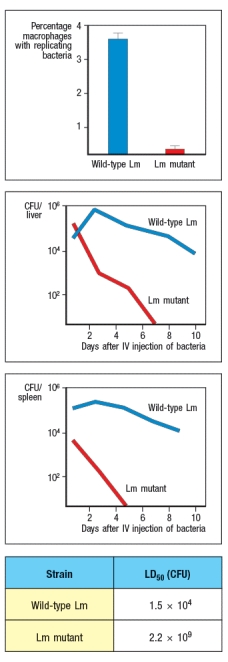Listeria monocytogenes is a Gram-positive facultative intracellular bacterium. Infection with L. monocytogenes is the leading cause of food-borne illness. After uptake by phagocytic cells (e.g., macrophages) in the infected host, L. monocytogenes replicates to high levels in the macrophage cytosol, and then travels to neighboring macrophages by polymerizing cytosolic actin, and using these 'actin rockets' to traverse into an adjacent cell. A mutant strain of L. monocytogenes (Lm-mutant) has been identified that shows greatly reduced virulence in animal models, and is impaired in its ability to establish a focus of bacterial replication in isolated macrophages in culture, when compared to wild-type L. monocytogenes (wild-type Lm). Additional data indicated that wild-type Lm and Lm-mutant strains were equally efficiently phagocytosed by macrophages, indicating no defect in Lm-mutant bacteria in gaining access to their target host cell. 
The graphs in Figure show: (top) % macrophages with large numbers of replicating bacteria after in vitro infection; (middle and bottom) CFU per liver or per spleen following infection of mice with non-lethal doses of bacteria. The table shows the LD50, a measure of the dose of bacteria that will kill 50% of the mice following infection.
a) Based on these data, name two possible functions of the gene missing in the Lm-mutant strain.
To assess the function of the defective gene in the Lm-mutant strain, wild-type Lm and Lm-mutant bacteria were used to infect isolated macrophages and the subcellular localization of individual bacteria was examined by electron microscopy. Representative images of a timecourse post-infection are shown in Figure 
b) What is the most likely function of the gene that is defective in the Lm-mutant strain and what is the fate of the Lm-mutant bacteria?
L. monocytogenes infection triggers a broad range of immune responses. Early after infection, L. monocytogenes induces innate immune responses consisting of the production of several pro-inflammatory cytokines and other mediators. This results in elimination of most of the bacteria. However, complete clearance of the L. monocytogenes infection requires an effective T cell response targeting the bacterial antigens. Thus, mice that lack T cells become chronic carriers of L. monocytogenes after infection.
c) Which subset of T cells is most likely to provide the protective immunity to wild-type L. monocytogenes?
d) Would you expect to see an altered T cell response to macrophages infected with Lm-mutant bacteria compared to those infected with wild-type Lm? Explain your reasoning
Correct Answer:
Verified
View Answer
Unlock this answer now
Get Access to more Verified Answers free of charge
Q33: HAART therapy is widely used in the
Q34: A common misconception is that our immune
Q35: The Borrelia hermsii spirochete causes a relapsing
Q36: The first drug treatment for HIV licensed
Q37: HIV-infected patients that progress to AIDS suffer
Q38: Listeria monocytogenes is a bacterial pathogen that
Q39: Evidence indicates that HIV-1 and HIV-2 originated
Q40: In the case of HIV infection by
Q42: Antiretroviral drugs are effective at blocking HIV
Q43: Common variable immunodeficiency (CVID) is a rather
Unlock this Answer For Free Now!
View this answer and more for free by performing one of the following actions

Scan the QR code to install the App and get 2 free unlocks

Unlock quizzes for free by uploading documents